Dead Man Standing
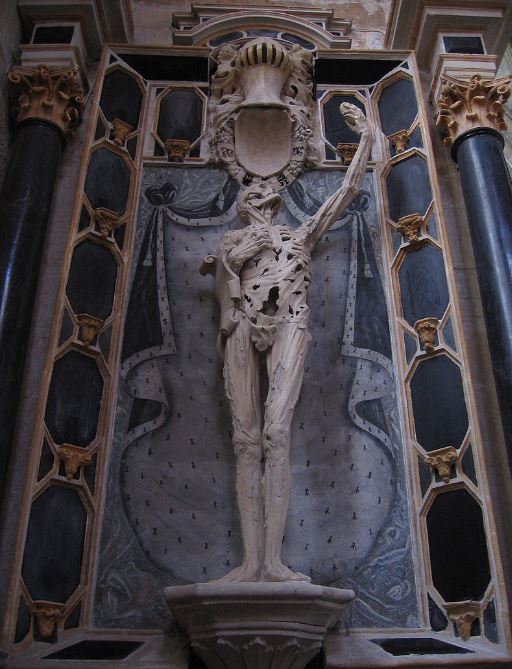
Dead Man Standing. Le Transi de Rene de Chalon
While I am a huge fan of Le Transi de René de Chalon, at the Church of St. Étienne, Bar-Leduc, France, seen above, the sad reality is that a corpse is a limp pile of meat. “Dead weight” is no mere expression. The dead cannot stand by themselves.
Naturally there are a few exceptions such as persons struck by lightning or electrocuted and the mummified, frozen, or heavily embalmed (see below). Rigor might occasionally occur in a way to temporarily allow a corpse to remain freakishly upright. But there are many vintage anecdotes about Resurrection men baffling the law by smuggling corpses sitting upright in a carriage—the corpse of Baroness Marie Vetsera was said to have been removed from Mayerling in this manner–or inconveniently dead men being “walked” as if they were drunk as in this story:
GRIM RUSE TO REMOVE A DEAD BODY.
The New York police are investigating a ghastly incident, which is alleged to have occurred in connection with the death of Mr Goodale, of Watertown, New York State, a well-known millionaire. While visiting New- York last month Mr Goodale died suddenly in an apartment in Forty-seventh Street, where he was dining with a friend and two women. The landlady refused to allow the undertaker’s hearse to take away the body, asserting that it would injure the reputation of the house. Mr Goodale’ s physician and. the coroner were summoned, and the latter, it is said, agreed to keep the matter secret to prevent a possible scandal. Mr Goodale’s companion is said to have then sent for another friend, and late at night the two men, arm-in-arm with the corpse, walked to the nearest cab-stand. During their grim journey they pretended that the dead man was only intoxicated. They staggered about the pavement and addressed jocular remarks to the corpse. Although the streets were crowded with people coming from the theatres, the deception was never noticed, When the cab was reached, the body was placed in it and conveyed to the undertaker’s, a generous gift sealing the driver’s lips. Star 6 April 1905: p. 2
Fair enough. But even with exceptions, it is nearly impossible to get the dead to stand on their own two feet without considerable assistance from the living. Which brings me to a point of considerable annoyance.
Recently this article on post-mortem photographs was published by the BBC. Now, rightly or not, I still have this nostalgic vision of the BBC as home of quality journalism, received pronunciation, and gravitas. But the BBC should be ashamed of itself for printing a piece that looks like it had been researched on Buzzfeed or its ilk. The article claims as post-mortems photographs of persons who are patently not dead, states that an obvious pre-mortem of a dying woman has had its eyes painted open, does not cite sources except a single mention of an Australian library, and, most damningly, repeats a canard that has been refuted again and again, about the dead being propped in a standing position for a post-mortem photo. [This site covers the question so well, I’m not sure why I’m bothering…] But indulge me while I rail against this beloved Victorian mortuary falsehood, with little hope that it will make the slightest difference to those who Believe.
I will warn those of you with sensitive stomachs or advanced degrees, that I am all about the primary source.
Here’s the gist: Somewhere the fanciful idea got started that some dead Victorians were photographed in a standing position, supported by metal propper-uppers. If you can see the base of a metal stand behind a Victorian photographic subject, it means the subject is really and truly dead.
This is patently absurd and there are many sites out there that will patiently explain why it is absurd. Here’s one of the best. As that site points out, the metal stands pictured were headrests to keep the head of a subject still for a long photographic exposure—lightweight articles that could not physically support the dead-weight of a corpse. But, of course, the notion of the standing dead is a fun fact that many people just love and Ebay sellers, who may be ignorant or exploitive, repeat the old lie in listing after listing of “post-mortems,” no matter how blatantly lively the actual subject.
Would actual contemporary sources help to dispel this fantasy?
Looking at nineteenth-century medical/forensic texts, we see much excitement that post-mortem photographs will aid in identifying the unknown dead. Those commercial photographers who specialized in “securing the shadow ere the substance fade,” generally wanted to show a corpse in repose; “not dead, but sleeping.” The recumbent position, in coffin or on a chaise longue, was essential to the illusion.
Forensic photographers had no such illusions. It was obvious that a) dead people can look remarkably dead and b) a positive ID was much more likely if the person was posed like a living person.
One of the most famous pioneers in post-mortem photography for the identification of the unknown dead was Dr. Nicolas Minovici, who used a variety of special techniques to bring les inconnues back to life.
Photographing the Dead for Identification.
The London Lancet states that the coroner has on two recent occasions commented on the unsatisfactory character of the photographs of the unidentified dead taken by the police authorities. It adds that Doctor Miniovichi [Minovichi] has contributed a valuable report on this subject from his experience as director of a Medicolegal Institute of Bucharest. He describes his method in the Archives d’Anthropologic Criminelle. He substitutes artificial eyes and gives a natural appearance to the lids by means of lead foil or by pinning them to the eyeball with small pins. The jaws are drawn together with threads, and the face drawn to a natural expression by means of pins, evacuating accumulations of gas by means of incisions in the scalp or mouth. He gives photographs of the various steps in photographing the dead and states that he was able in one case to fully establish the identity by means of the photograph, the body having been in the water for six weeks. Physician and Surgeon: A Professional Medical Journal, Volume 28, 1906
You can read about Dr. Minovici’s artifices and see before and after photographs of some shockingly decayed and disfigured corpses in the Archives. It is not for the faint-of-heart, but our weeper-trimmed hats must be off to Dr. Minovici—he worked astonishing transformations on bodies that seemed beyond humanity.
Minovici describes and illustrates the chairs and supports he used to photograph corpses. Here, for example is a corpse in a special posing chair.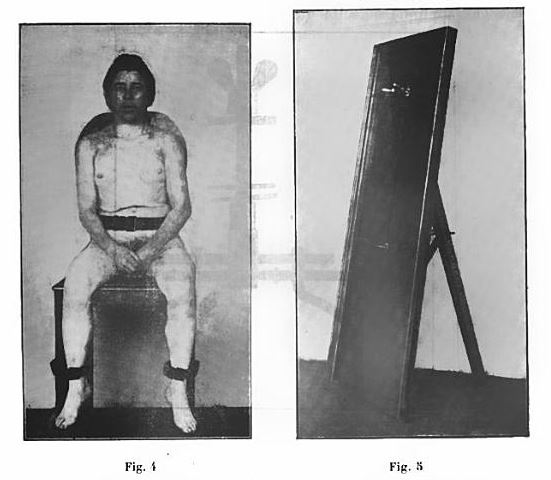
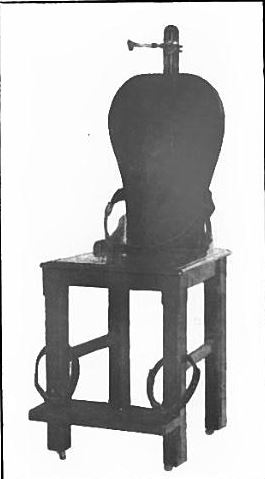
The table [fig. 5] was also used—it tipped over; the body was fastened at neck and crotch; then the table was set upright.
Here is another table to hold the body upright, used in the morgue at Geneva:
This table and its accompanying text really ought to put paid to the notion that a corpse could be stood on its feet for a photograph.

An illustration of a table/litter used for photographing corpses. It could be laid flat, or adjusted to hold the body upright. The inventor recommended clamping the head of the corpse “otherwise a slow sinking of the body occurs which renders photography very difficult, especially if a long exposure is required….
“The author [Dr. H.T. Gosse] has obtained excellent results with this apparatus, which is cheap and easily put together. He has employed it especially in the identification of unknown bodies deposited in the Morgue at Geneva, and since the introduction of this method the mean of the corpses classified as unknown has fallen from forty to five or six per cent.” The Photogram, Volume 5, 1898
What did commercial photographers have to say about their post-mortem subjects’ poses? Looking at interviews with photographers who did such work, we find statements like “The photographer lifted the little corpse out of the coffin and stood it up in a chair. The nurse held it in position and a flashlight picture was made.” And when a photographer was called to take a photo of a dead coachman whose widow insisted he be photographed on the box: “So we carried him out to the stable, tied him on the box in full livery, with the lines and whip in his hands, and photographed him.” The Topeka [KS] Daily Capital 18 July 1885: p. 3
This particular artist also mentions that he has taken photographs of persons in coffins and on beds, while children were placed in parents’ arms or set up in chairs. But there is no mention of standing poses for the dead or of using a headrest to support them, as, indeed, there is no mention in any of the photographic journals or photographers’ accounts I’ve seen.
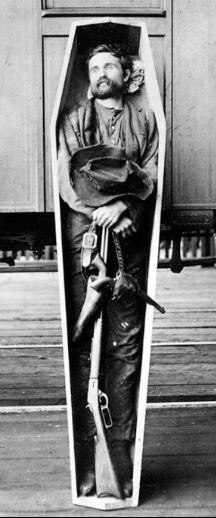
Rube Burrow, notorious train-robber, post-mortem
A popular sub-genre in post-mortem photography was images of the corpses of notables or outlaws photographed out of doors, usually in a coffin set on its end. The corpse of Manuel Morales, who threw a bomb at King Alfonso of Spain and his wife, and shot himself while trying to escape, was photographed “in a standing position, the body held up by two men.” British Journal of Photography, Vol. 53, 1906
I’ve run across two references to photographing the standing dead, one this frozen body:
An Irish family, living in the southern part of the city, called on me about two years ago to take a picture of their dead son—a young man—with his high hat on. It was necessary to take the stiffened corpse out of the ice-box and prop him up against the wall. The effect was ghastly, but the family were delighted, and thought the hat lent a life-like effect. Photographic Times and American Photographer, Volume 12, J. Traill Taylor, Editor, 1882 [The “ice-box,” as I’ve written about in these pages, was meant to freeze the corpse solid.]
A western “tent photographer” noted a cultural difference:
I was tenting in an Arizona town and quite a number of Mexican children died. These people are quite fond of pictures, and seem to like corpse ones if they have none taken in life. Most of them in the town I was in preferred having them standing, so I ordered them to place the corpse against the back of a chair and tie it thus outside of their doby house in the sun; and I will say that a standing corpse picture looks much better than one lying down. “Nine Years a Tent Photographer,” E.A. Bonine, Anthony’s Photographic Bulletin, 1898.
There are also photographs of show mummies, like Elmer McCurdy or “John Wilkes Booth,” embalmed with tissue-stiffening potions, such as this one:
MODERN EMBALMING
“How do you embalm now; what chemicals are used?” “Oh, there are a number of processes. Dr. Chaussier had the body thoroughly emptied and washed in water and kept it saturated in corrosive sublimate. The salt gradually combines with the flesh, gives it firmness and prevents decay, and in process of time the flesh becomes as hard as wood. The Cincinnati [OH] Enquirer 3 August 1885: p. 8
An Ohio undertaker named Pearce kept an embalmed corpse as a specimen of his work:
The “subject” has now done service for a period of three years and the proprietor confidently expects that it will last as long as he remains in business.
The body in question has been in the very warmest workroom of his establishment all this while and the leatherlike flesh of the corpse is totally free from odor or putrefaction…Formaldehyde, a product of wood alcohol and a comparatively recent product, is the fluid ..used for the desiccation of the body in question. The Cincinnati [OH] Enquirer 17 October 1897: p. 19
An Atlanta doctor went the leathery corpse preparers one better:
SECRET
Taken From Nature
Atlanta Doctor Discovers a Certain Method
Of Transmuting Human Bodies Into Stone.
Placed in a Case That is Made Air-Tight
And Treated With Chemicals, the Principal one Being Silicon Dioxide in a Liquid Form
Atlanta, Ga., July 18. A process of preserving human bodies, known to the ancient Egyptians, lost, sought for in vain by chemists and alchemists for more than 2,000 years, has been discovered by Dr. Arnold Rosett, of Atlanta.
Unlike the method practice by the priests who laid the Pharaohs in their sculptured sarcophagi, the process of Dr. Rosett is not one of mummification, but turns human flesh into heavy white stone… Dr. Rosett can change, and has changed in his laboratory, human bodies and parts of human bodies into glistening silicon in from four to six months. The length of time varies with the condition for the subject at the time of death, the character of the drugs given in the last illness having much to do with determining the length of time necessary for the chemicals used to work upon the flesh. Cincinnati [OH] Enquirer 19 July 1903: p. 9
Perhaps it was stories of petrified corpses or articles on embalming that suggested that a body could be stiffened enough to stand with only the negligible support of a headrest. But it is obvious from accounts by forensic post-mortem photographers, doing work where a standing portrait was most desirable, that an apparatus more substantial than a simple headrest was necessary to put the dead back on their feet.
And yet…. There is this poignant woodcut, taken from a photograph which accompanies a report on the autopsy of a toddler with Pott’s Disease.
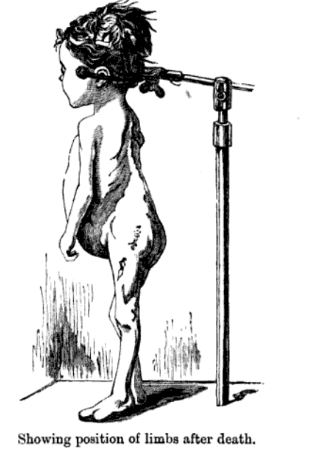
After death, a photograph, from which the accompanying woodcut was obtained, was taken by Mr. Mason, of Bellevue Hospital, by simply suspending her in a head rest. Transactions of the International Medical Congress, Seventh Session, 1881
Theories as to why, in the face of so little evidence, the myth of the standing corpse persists? Or proof (Buzzfeed doesn’t count) that it isn’t a myth. chriswoodyard8 AT gmail.com.
This conclusive, meticulously-researched article on several Victorian post-mortem photography myths was just sent to me by the author, Edward Clint. Do read and share it!
Chris Woodyard is the author of The Victorian Book of the Dead, The Ghost Wore Black, The Headless Horror, The Face in the Window, and the 7-volume Haunted Ohio series. She is also the chronicler of the adventures of that amiable murderess Mrs Daffodil in A Spot of Bother: Four Macabre Tales. The books are available in paperback and for Kindle. Indexes and fact sheets for all of these books may be found by searching hauntedohiobooks.com. Join her on FB at Haunted Ohio by Chris Woodyard or The Victorian Book of the Dead. And visit her newest blog, The Victorian Book of the Dead.
